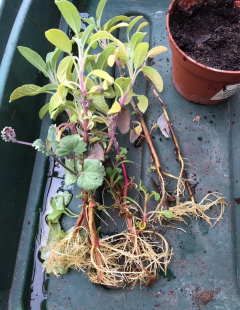

How to Grow The Herb Sage
Sage is an easy to grow, evergreen perennial herb which originates from the Mediterranean. These origins translate into growing conditions which are basically sunny, with free draining soil which does not become waterlogged.
Sage is a shrubby plant and is very hardy. As a Mediterranean herb, it needs a spot which is dry and sheltered. A bad winter can damage the plant, especially if it is wet. If it looks particularly sad after a bad winter you can cut it back and it should sprout up fresh growth and rejuvenate itself.
If the ground conditions are not ideal, sage is easy to grow in containers and requires no maintenance. Although it can look a bit tired after winter, as soon as spring arrives, it picks up and produced new fresh growth. The leaves are very soft, almost downy and it makes a good garden shrub, being neat and well behaved, growing into a tidy round mound growing up to around 60cms. The image top right illustrates this, and left a pretty variegated sage.
You can grow Sage from seed but it’s a bit fussy. You can sow the seed direct into compost, outside if the risk of frost has passed and do not exclude light, and always keep moist. It is easier to grow as a small plant or from cuttings, (see below).
These varieties are Salvia officinalis, the culinary Sage into which group Rosemary has recently be re assigned.
An Easy Way to Grow Sage From A Cutting

If you find taking and rooting cuttings in the traditional way difficult, here is an easier method.
Take a cutting of a similar size as in the image left place in water for a couple of weeks. The cutting will grow lots of roots as shown, and then you can pot it up into a small pot and grow on.
It may take a few months, or a season, but it will root well and be garden ready.
This is a simple way to raise plants from cuttings . This also works for Sedum, Mint herb and Nepeta, penstemon, Rosemary, Pelargonium, Artemisia and Basil.
